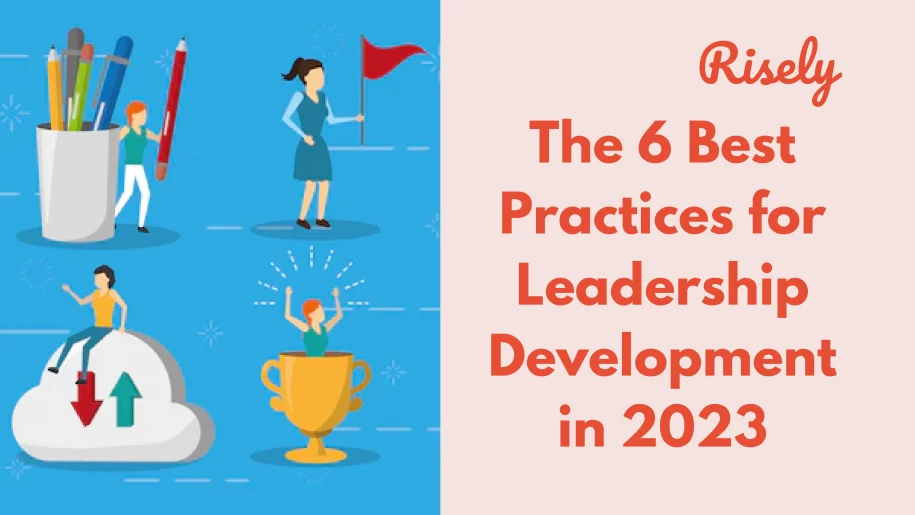The 6 Best Practices for Leadership Development in 2023
Yes, leaders are different from one team to the next. And the best-suited leader differs too. Effective leadership is essential for any organization to succeed, and by following the best practices for leadership development outlined in this blog, you can develop the skills and mindset needed to become an effective leader. This blog will take you through some of the best practices for leadership development that managers and organizations can use. Whether you are a new leader or an experienced one, these best practices will help you to become a more effective leader and drive success for your organization.Why Is Leadership Development Important?
Leadership development is crucial for individuals who aspire to be better leaders in their organizations or community. It provides the opportunity to learn from experienced leaders and apply their skills and expertise in a real-world setting. Additionally, leadership development can help build team morale and cohesion by improving communication and collaboration between team members. Leadership development can help organizations improve performance and achieve organizational goals by training influential leaders from within the organization. In addition, it helps create a positive work environment by fostering communication and cooperation among team members. Following the best practices for leadership development also helps develop a strong work ethic apart from other benefits and thus leads to sustained success in the workplace. In addition to creating a solid leadership foundation, leadership development helps organizations identify future leaders who can carry on the organization’s goals and mission. Leadership development is essential for organizational success and ensures that teams have influential leaders capable of driving growth and success. Apart from the benefits for the organization, developing leadership skills helps an individual become better problem-solvers and increases their self-esteem and confidence.Leadership Development Model
A leadership development program is an effective way to help leaders become better leaders and improve their skills in a variety of areas. A leadership development model is a framework or approach used to identify, develop, and assess the leadership skills of individuals within an organization. A well-designed program can help leaders develop the skills and abilities needed to be more effective, efficient, and insightful leaders. There are many different models that organizations can use, but they typically include the following steps:- 1. Assessment: This step involves identifying the organization’s current leadership skills and potential. Organizations can use 360-degree evaluations, personality tests, or skill assessments to get data on the skills of their managers or leaders.
- 2. Development: A plan is then developed based on an individual’s leadership skills and potential. This plan includes training, coaching, mentoring, or other development activities.
- 3. Implementation: The next step is implementing the leadership development plan, and the individual begins to work on developing their leadership skills.
- 4. Evaluation: Evaluation of the progress of the individual is essential to determine the effectiveness of the development plan. Evaluation includes tracking progress, measuring performance, and providing feedback.
- 5. Reinforcement: Managers can adjust their development plan to reinforce learning and progress based on the evaluation.
The Six Best Practices for Leadership Development
Best Practice #1
Create personal development plans with leaders
One of the best practices for leadership development is creating personal development plans for managers/leaders to improve their skills and knowledge. Individual development plans with leaders can help them stay agile and responsive to organizational changes. Leaders should tailor their development plans to reflect the leadership skills and competencies unique to the individual leader. Managers should periodically review a personal development plan to ensure it is still relevant and practical. Leaders must also be willing to self-reflect, especially if they feel their development plan is lacking or not working. By regularly updating and reviewing their development plans, leaders can ensure that they are continually improving and staying up to date with current best practices in leadership. Creating personal development plans all by yourself can seem like a daunting task. But you don’t have to worry about that since Risely is here for you. Risely is your daily partner in your journey of professional and personal development. It helps to map the specific challenges you face and then provides you with customized solutions on how to deal with them. Sign up for Risely now to avail all the benefits!Best Practice #2
Leverage Tools for Personalized Leadership Development
Another best practice for leadership development is to use a personalized leadership development model. This model should be designed specifically for the needs of the individual. In addition, they can use these tools to measure progress and track changes over time, which helps ensure that the leadership development process is effective and meaningful. The goal of using tools is to help individuals grow in their leadership abilities while maintaining autonomy and freedom of choice. Individuals can improve their leadership skills rapidly and effectively by using a personalized leadership development model and tools to track progress and change over time.Best Practice #3
Use Micro and Macro Learning Effectively
Macro and microlearning is another best practice for leadership development, these are two different approaches to learning that organizations can use for leadership development. Macro learning refers to large-scale, comprehensive learning programs that cover a wide range of topics and skills over an extended period. Conversely, microlearning refers to shorter, focused learning sessions that cover specific topics or skills. When used effectively, macro and microlearning can complement each other to provide a well-rounded and effective leadership development program. It is important to note that the balance between macro and micro learning is determined by the specific needs of the organization and the learners, and it is essential to evaluate the progress and adjust the learning program as necessary. For example, managers can use macro learning for in-depth learning on a particular topic or skill. In contrast, microlearning can be used for just-in-time learning, providing quick and easy access to information when needed.Other Interesting Reads
Best Practice #4
Use Assessment for Development
Assessment is an essential tool for leadership development, and leaders and managers can use it to help identify strengths and weaknesses in a program. By identifying areas for improvement, leaders can ensure that their leadership development program is effective and sustainable. As with any assessment, it is essential to use the results of a leadership development assessment to improve the program and continually improve and strengthen its effectiveness. Besides using assessment to identify strengths and weaknesses in a leadership development program, you should also use the results to learn more about yourself and your leadership performance. This information can help you improve your leadership skills over time and better position yourself for advancement in your organization. Are you thinking of taking some skill assessments for yourself but need help knowing where to begin? Then, check out Risely, which makes this task much more manageable. We offer free self-assessments on various skills essential for any manager, which helps you analyze your strengths and weaknesses. We also help you work on your skills and keep track of your improvements so that you can flourish in your role as a manager. Sign up for Risely to avail all the benefits.Best Practice #5
Create Peer Learning Groups
Peer learning groups are one of the best practices for leadership development that helps develop individual skills and promote teamwork. A peer learning group is a group of individuals who come together to share knowledge, experiences, and perspectives and to support each other in achieving their goals. Therefore, clearly defining the goals and purpose of such groups is essential. Also, this practice for leadership development works best when attention is on having an inclusive a diverse group, and active participation from all is encouraged with the help of various learning methods like case study evaluation, role-playing exercises, guest speakers, etc. They allow leaders to share their experiences and learn from each other. A leadership development program or an organization’s management can facilitate peer learning groups. The best practice is choosing a group relevant to the leader’s role and their teams. In addition, leaders must stay involved in the peer learning group after completing the program. By staying engaged, leaders can continue to develop their leadership skills and learn from each other.Best Practice #6
Having Rotational Shifts
Rotational programs involve exposing employees to different roles and responsibilities within the organization. The idea behind rotational programs is that by allowing employees to work in other areas of the company, they will develop a broad understanding of the organization’s operations and be better prepared for leadership roles in the future. These programs usually include a series of assignments in various departments or functions within the company, and the duration can be from several months to several years. These programs give employees a variety of experiences and expose them to different aspects of the business. Rotational programs help in expanding one’s network within the company and in building diverse sets of skills. It also helps future leaders in developing a broad perspective and understanding of the company’s operations, It is important to note that rotational programs can be challenging, and it is crucial to provide support and guidance for employees going through the program and ensure that the rotation aligns with the company’s overall strategy and goals. Here are the 8 essential leadership skills for every great team manager.Conclusion
Leaders are bound to face challenges, and development is essential for ensuring long-term success. Leaders who continue to evolve and improve their leadership skills can better adapt to changing business conditions and other leaders’ leadership styles, leading to tremendous organizational success. Leaders who identify best practices for leadership development and incorporate them into their organizations and teams can be more effective in enhancing their employees’ development while fostering a leadership culture. It is important to note that the best practices will vary depending on the specific needs and goals of the organization and that a combination of different methods and techniques may be necessary to achieve the desired results. It is also vital that the leadership development programs are inclusive and diverse and align with the company’s culture and strategy. Investing in best practices for leadership development can lead to improved performance, increased employee engagement, and a more effective and efficient organization overall.Rise in professional ranks with a growth mindset that sets you apart
Get the free growth mindset toolkit for managers to unleash your true potential
Other Related Blogs
Building an Ultimate Leadership Development Action Plan
How to Build a Leadership Development Action Plan? Having a strong Leadership Development Action Plan is more critical than ever in today’s evolving business world. Whether you’re looking to drive…
Leadership Journey Examples on the RiseUp Radio Podcast
Leadership Journey Examples on the RiseUp Radio Podcast Leadership isn’t a destination – it’s a journey filled with twists, turns, and transformative moments that shape not just careers, but entire…
What is Immersive Learning? A New Era in Education
In this blog, you’ll learn what is immersive learning and how it is changing training, increasing engagement, and influencing the future of workforce development. … Read More
What are Learning Designs? All You Need To Know
This blog explains what learning designs are in depth while also covering it’s key components. It tells you about the process involved in creating a good learning design along with…


